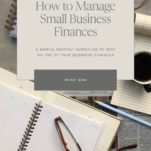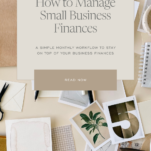Keep Reading
How to Manage Small Business Finances | My Monthly Money Workflow
Confession: I’ve totally been that person a week before taxes were due sorting through receipts and trying to get my quickbooks up to date. I know from experience that if you don’t make room to stay on top of your finances consistently, it’s a task that inevitably ends up on the back burner. Which is […]

Paragraph
Confession: I’ve totally been that person a week before taxes were due sorting through receipts and trying to get my quickbooks up to date. I know from experience that if you don’t make room to stay on top of your finances consistently, it’s a task that inevitably ends up on the back burner. Which is why I’m sharing on the blog today my go-to workflow for how to manage small business finances.
When Kyle and I first started working in finance together we would meet on Friday mornings at Panera Bread to review our goals for the week, sales numbers, and to hold each other accountable. When we started dating we started lovingly referring to these breakfast meetups as our “money dates” and the title stuck!
From sales goals to personal financial talks to marketing metrics, these money dates have been a staple in our family since 2009 (and something I’ve now passed down to hundreds of my students in The Blueprint Model!)
Money date, duty day, finance Friday —whatever title you love best, your small business deserves at least one day a month to get down to the nitty gritty dollars + cents.
The #1 thing I get asked to share (other than how I pay myself → that blog coming soon!)… How do I keep track of my finances?
Ask and you shall receive….
My monthly money workflow for how to manage small business finances ⬇️
DON’T LEAVE WITHOUT YOUR FREE WORKFLOW PRINTABLE GUIDE
Step One: Duplicate Your Workflow Task & Assign to the Upcoming Month
Albert Einstein says “never memorize anything you can look up” so I’m a huge believer in creating a workflow once, writing it down (!!) and re-using it time and again.
I use Asana for my project management software (and love it BTW). So step one is to duplicate this task in Asana and assign a new task for the upcoming month. This way I always have my money date on the calendar and that day blocked off from other business tasks.
Whether you use a project management software like Asana or simply print off this workflow and keep it with your planner, whatever system works best for you is the best system!
Ps. I have a financial workflow for both home and business. I’ll put together a separate post all about my financial workflow for our personal finances. I do both home and business on the same day. It takes all day to do both, my brain is tired by the end of the day, but this system allows me to review my finances just once a month and leaves me feeling confident about my money.
Dying to get your hands on my actual Asana templates + monthly workflow for business and personal finances? Say no more! Shop it all right here.
Step Two: Categorize Spending (Expenses)
Let’s dig into the numbers! I start by categorizing spending (also known as expenses). I use quickbooks online but any bookkeeping software will work (find one that works for you). When choosing software, make sure your transactions are automatically added from your bank accounts/credit cards/and or payment processors. If you don’t use a bookkeeping software (or if your software doesn’t automatically pull in transactions) you can manually enter transactions in a spreadsheet like excel or google sheets.
Once you have more than 25-50 transactions per month, I highly recommend using a software that automatically syncs with your accounts because it’s easy to miss things if you’re doing it all by hand.
For those of you who outsource bookkeeping, your bookkeeper will do this for you.
We have three accounts that I review each month. Our business checking account, our business credit card (we use Amex), and our tax savings account.
When it comes to categorizing your spending, I always say you want to be detailed enough that it means something to you, but not so detailed that you won’t do it. For example: you want an office supplies category, but not necessarily a paper clips category!
Step three: Input Income (Revenue)
For 1:1 Clients:
For 1:1 clients, I input payments for my one on one clients first as they are usually bigger chunks and quicker to review. Next, I invoice my clients directly through Quickbooks Online and they pay through the quickbooks payment processor. I have clients that are billed directly and others that have setup automated payments. All of these are processed through Quickbooks. I don’t get physical checks any more but if/when I did, I mobile deposit them immediately upon receipt into my bank. All I have to do each month is “match” each payment with the invoice. This decreases the open balance on the invoice by the amount of the payment.
For Online Courses + Digital Products:
From there I input payments received from my payment processor. We use Stripe as our payment processor. This is the most tedious part of the process because stripe deposits payments in chunks (not individually) so I have to manually input them. The easiest way to categorize income from stripe would just to label it all as “sales” or “online sales” but as I mentioned with expenses you want to categorize transactions detailed enough to be meaningful. So, I like to see sales broken down by revenue streams.
For me, I have 3 main products I sell: The Blueprint Model, Blueprint at Home, and My Blueprint Year. I also have smaller revenue streams like affiliate sales that I just bulk all together (some people may want to see their affiliate revenue more broken down but for me this isn’t a major source of revenue).
For all my students in The Blueprint Model, you know I use these revenue streams strategically to understand where to invest most of my time. Inside The Blueprint Model I call this a “profitability audit” and we revenue time cost versus product profitability to strategically work smarter not harder.
Step Four: Send Invoices and Payment Reminders
This is pretty simple for my 1:1 clients as I setup invoices to be generated on the 1st of every month automatically. Before I had this option, I always invoice clients on the 1st of the month that their project is due.
For example: If I was a floral designer and took a 50% retainer at the time of booking, I would bill the remaining 50% on the 1st of the month that their event is happening. I often see clients state in their contract that final payment is due “two weeks before the wedding” and while that totally makes sense, I just say make your life easier and let them know final payments are billed on the 1st of the month. This way you can handle off of this one day and don’t have to worry about billing a client for a wedding in two weeks when you’re trying to crank out flowers for your event tomorrow! Inevitably you’ll forget to bill when you’re busy.
As far as payment reminders, any invoices that have not been paid by my 1:1 clients, my team emails a reminder directly. Same with any online payments that have been declined, we email for updated payment information. We have a workflow for declined payments as well that gets put into motion after a payment has been declined twice. Simple systems and workflows like this help make how to manage small business finances so much easier.
Step Five: Pay Bills
I setup as many bills as possible on autopay including all my software subscriptions, internet and telephone, and even my credit card is paid in full automatically each month. Since I work with a lot of contractors, I pay their bills during my money date or setup automated payments if that option is available.
I do have a virtual assistant that works for me hourly and is paid every two weeks. I’ll talk more about how I pay her below as I don’t do this on my money date.
In the past I’ve also paid my quarterly tax estimates (due April, June, September, and January) on my money date. I just set a calendar reminder since this isn’t done every month.
Step Six: Pay Myself as a Business Owner
My company is licensed as an LLC so I do not run my pay through payroll. My salary and bonuses is classified as an “owners draw” in quickbooks and shows up on my balance sheet (not on profit and loss). I know that can sound super technical and accountant-y but I’d recommend talking to your CPA. Once you set it up once it’s super simple but how you classify things depends a lot on how your business is licensed and how much your company makes each year.
As an LLC, I paid quarterly tax estimates.
Currently I “elect to be treated as an S-Corp” for tax purposes so my CPA does a one time “payroll” withdrawal at the end of the year to cover taxes for our personal salary + bonus withdrawals.
Step Seven: Reconcile Business Accounts
This is one that is often forgotten but will make your life so much easier come tax time as a small business owner. Do you remember back in the day “checking your work” on math problems? It’s like that. Or better yet, it’s like the good ole days of actually balancing your checkbook! If you use an accounting software “reconciling your accounts” is just a fancy way of saying to double checking your work. You want to make sure all the income and expenses transactions that show in the bookkeeping software match the income and expenses transactions in your bank account.
Even if you don’t use a bookkeeping software, you want to go back and double check that everything you’ve entered into your spreadsheet match what your bank account says. I recommend printing off your bank statements, it makes life so much easier! Or if you have a big screen, I pull up my quickbooks and my bank statement side by side so I can double check them.
Technically for your CPA to file taxes, your accounts should all be reconciled. This ensures that your profit & loss statement is actually correct.
Step Eight: Prep Cash Flow Plan for Upcoming Month
I personally believe this is the most important part of the entire day. It either gives me peace of mind or tells me I need to kick my butt in gear! A cash flow plan is just a fancy way of answering “do I have enough?”
I input my starting bank balance in my business checking account (my main account), all my anticipated income and expected expenses (including my business credit card balance which I pay in full each month) and then calculate my ending balance. Is there enough? If not, I need to come up with something to sell or work to book another client! This practice gives me peace of mind and helps me ensure there is always enough. (Curious what your enough number is? Read this post next.)
Step Nine : Review P&L for Year Against Annual Money Plan
My favorite part of the day, and equally as important as the step before is comparing my actual income and expenses (using my profit and loss statement) against the money plan I created at the beginning of the year. This is the actual benefit of bookkeeping as a business owner, it’s the strategy part! How are you tracking towards your sales goal? Are you staying within your spending parameters in each of your expense categories?
We don’t want to create a plan and then never look at it. As I teach my students, we make the plan and then work the plan! That’s how I ensure I always have enough to pay myself.
Questions to consider:
How many clients have I booked for the year?
How many more do I need to hit my goal?
If sales are down, what needs to be adjusted?
If spending is up, what needs to be adjusted?
This ensures I don’t get to the end of the year with a completely busted budget or unreached sales goal. It allows me to make small adjustments along the way so I can ensure I hit the numbers I need to hit to pay myself, my team, and keep my business going without sweating bullets.
Also, this is the time to make sure you have enough saved for taxes. I look at my overall profit for the year and ensure I have 30% of that number set aside for taxes. I have a separate tax savings account I use for this. I’ll share more about this below, but if you’re looking at this each month you’ll always make sure you have enough money come tax time.
Step Ten: Scan, File and shred paperwork
Last but not least, scan, file and shred paperwork! I have a cute filing sorter from Target setup in my office and I keep paperwork I will need for taxes in folders there. I also use this scanner to scan receipts, and bills and attach to Quickbooks transactions (so I don’t have to keep the physical copy). Luckily, most things now are just done online so I attach the pdf bill directly to the quickbooks transaction. From there any paper I don’t need the physical copy for, I shred. This is the shredder I have.
—
So there you have it! My 10-Step Money Workflow that I follow every month to keep my business finances in check and up to date! I highly recommend setting a date on your calendar once a month (this year mine falls on the first Friday of each month) to follow this workflow and organize your own business finances.
I hope this helps,
Shanna
Don’t forget to snag your free copy of My Monthly Money Workflow Printable Guide. Click Here to Download.
Resources Mentioned in this Post:
Quickbooks Online Accounting Software
Asana Project Management Software
This Brass File Sorter (Hearth & Hand from Target)
Folders for Organizing Paperwork
Need help getting your small business finances in shape?
My Monthly Money Date Checklist : My simple system for staying on top of my business and personal finances each month, my monthly money workflow checklist + Asana template. Plus, a Quick Video Tutorial to help implement your own “money date”. **Available to all students inside The Blueprint Model**
The Blueprint Model : My Signature 12-week Business + Finance Program to simplify the math of business
My Blueprint Year : Annual Planning Course + 350-page Planner/Business Tracker
Blueprint at Home : My Personal Budgeting Course
Keep Reading:
Five Numbers to Know and Track in Your Business
How Making Money Dates a Priority Changed My Business (and My Life!!) – Student Case Study
Taxes for Entrepreneurs | 3 Ways to Prepare All Year for Tax Time
Updated April 15, 2024
Originally published August 1, 2021
SHARE THIS:
April 15, 2024
Previous Post:
Next Post:
And if you found this helpful, share with your friends!








Valuable note, Thank you